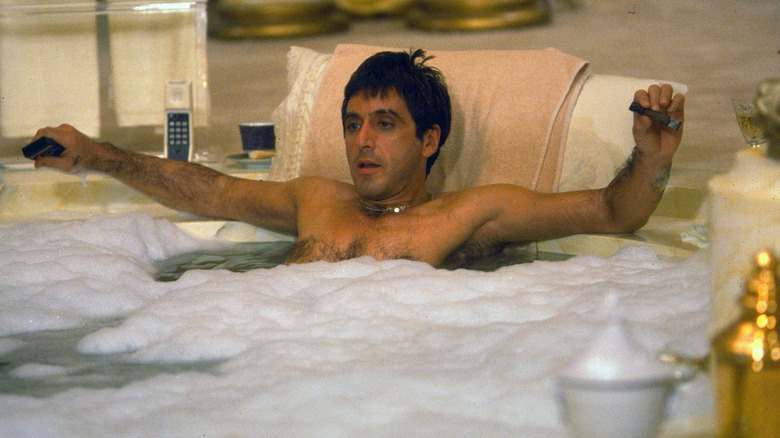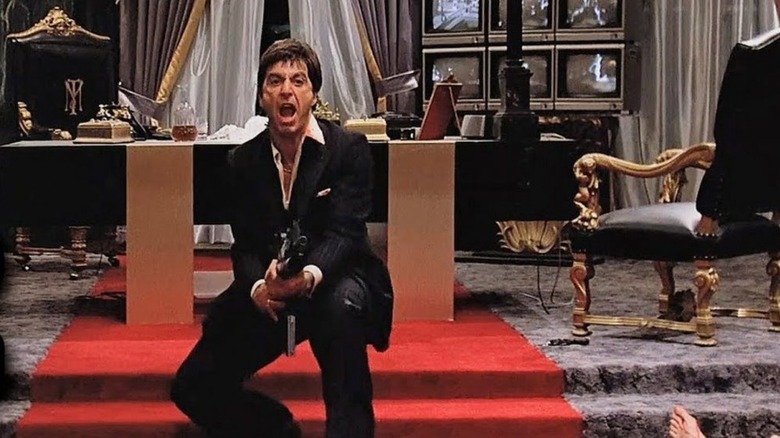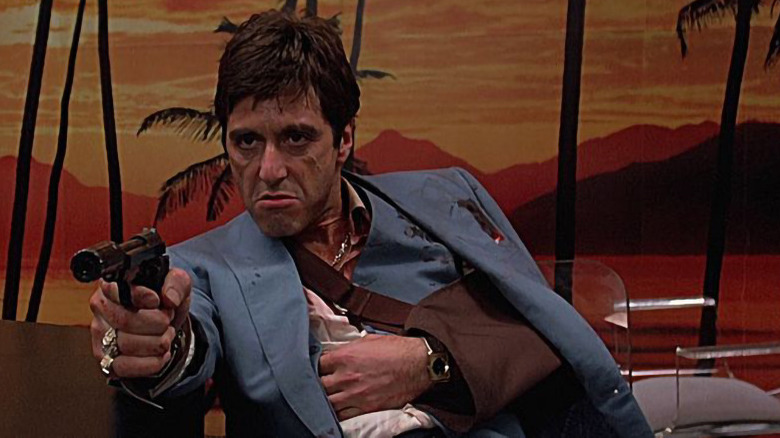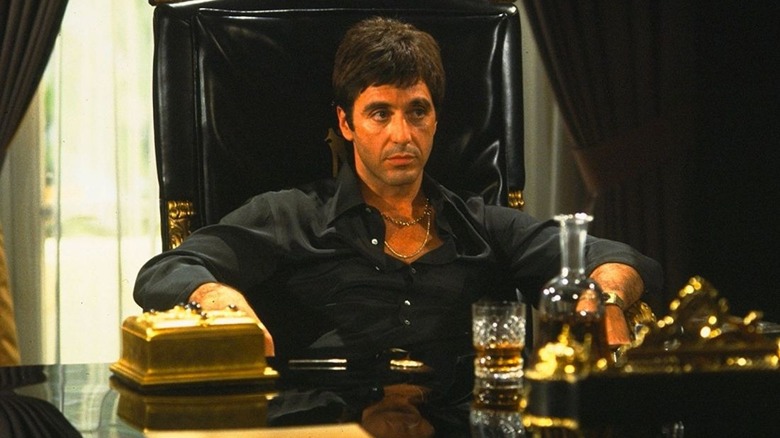The Scarface Controversy Explained
It's rare for iconic films to have achieved such status without some sort of controversy coloring their legacies. Such is the case with "Scarface," the 1983 crime drama starring legendary actor Al Pacino as the ruthless Tony Montana. The tale of the fictional Cuban immigrant turned violent drug lord has become culturally synonymous with the idea of obtaining the American Dream at all costs, revered by rappers, suburbanites, and edgy middle schoolers alike. While the passage of time can make it easy to forget, "Scarface" caused such a major uproar during its heyday that the film couldn't even begin production without intervention from government officials.
What was it about the classic '80s gangster movie that caused such controversy?
Potentially Problematic Inspiration
From its inception, "Scarface" was intended to be a gangster movie. Specifically, it was a remake of a 1932 film of the same name, with the original being inspired by the notorious Italian-American mobster, Al Capone. However, rather than make another "Italian Mafia movie," which screenwriter Oliver Stone stated there were already "dozens of," the film would swap one oft stereotyped group for another and focus on Cuban immigrants — an idea that Stone claims came from American director Sidney Lumet. In the book "The Oliver Stone Experience," Stone states, "Sidney has a great idea — he wants to do it as a Marielito picture in Miami. I said, That's interesting! Sidney's idea was a good one." While Lumet left the film due to creative differences, production continued on with Brian De Palma (who also directed the film adaptation of Stephen King's "Carrie") as director.
On the other hand, in 2011, actor Al Pacino stated that he was the one who was inspired to make "Scarface" after watching the original movie in Los Angeles at the Tiffany Theatre and calling up producer Martin Bregman, who then reached out to Oliver Stone. Whatever the exact origins, "Scarface" was set to be a film about violence, drugs, and Marielitos, with Miami as the backdrop.
Negative Stereotypes of Cuban Immigrants
Given this information, it's not surprising that much of the past controversy surrounding "Scarface" lay within its less than stellar portrayal of Marielitos — the name given to Cuban immigrants who came to America from Mariel, Cuba in order to escape oppression during the 1980s. Specifically, more than 125,000 people fled Cuba from the Mariel Harbor and ended up primarily in Florida. Of this number, around 20% were suspected to be "undesirables," ranging from petty thieves to criminally insane.
This figure mixed with America's track record of using a few bad actors from a given group (particularly when it comes to race and nationality) to justify the dehumanization of everyone from that group, made for the perfect storm of controversy when it came to "Scarface." It's understandable that a film that starred mostly non-Cuban actors portraying Cuban immigrants as violent, drug-addled criminals would be met with objection and opposition from the same community it was negatively stereotyping.
The Miami Government Got Involved
In addition to dissent from the Cuban-American community, "Scarface" drew such controversy that Demetrio Perez, Miami's City Commissioner at the time, became one of the most vocal voices of opposition against it. Perez alleged that the film would only further anti-Cuban sentiments in Florida by placing emphasis on the comparably small number of Marielito criminals and ignoring the fact that the majority of Cuban immigrants were simply seeking refuge from Fidel Castro's regime. He even went so far as to ask that the filmmakers dedicate at least 20% of the film to depicting Cubans in Miami engaging in "anti-Castro activities," to ”connect the 'Scarface' character as working for the Castro Government in an effort to discredit the Cuban-American people,” and ”not include any arguments that portray the Communist Government in Cuba or Communism in general in a favorable light." He also stated that unless his demands were met, he was prepared to effectively ban the production of "Scarface" in Miami altogether.
In an editorial for the Miami Herald, columnist Guillermo Martinez echoed Perez's sentiments, stating that "Scarface" would "tell the nation and the world that the prototype of the U.S. gangster of the 1980s was a Mariel refugee."
In response, producer Martin Bregman defended "Scarface" by dismissing such concerns in a way that, in my opinion, didn't really age well (and probably didn't look too great in the '80s, either):
”We are not doing a film about Cubans in Miami. We're doing a picture about one gangster. The movie has more crooked Jews than crooked Cubans.”
Yikes.
Ultimately, due to the concerns and controversy, the production of "Scarface" was moved from Miami to Los Angeles. It was eventually released in 1983, where it was initially met with a mostly negative critical response; however, the movie still went on to become a cornerstone of pop culture, serving as inspiration for a multitude of songs, videos games, merchandise, and articles written by tired college students. In fact, the 1983 remake of the 1932 film has even spawned an upcoming remake of its own.
Whether or not one personally enjoys "Scarface," its legacy and influence cannot be denied. I mean, who among us hasn't uttered "Say hello to my little friend!" at least once in their lives?



